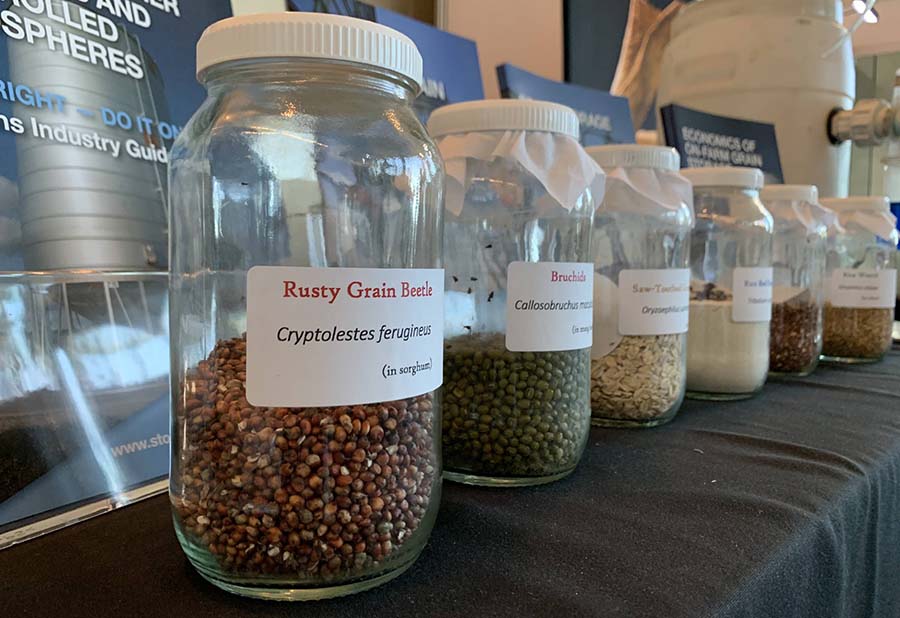The lesser grain borer (LGB) is the main pest threat for on-farm stored sorghum, while the rusty grain beetle (RGB) is the key threat to bulk grain stored sorghum, research by Dr Raj Jagadeesan, from the Queensland Department of Agriculture and Fisheries' post-harvest grain protection unit, has found.
Speaking at the 2019 Australian Summer Grains Conference on Queensland's Gold Coast in July, Dr Jagadeesan discussed the pest and resistance profiles for stored grain pests in sorghum following a two-year sampling study he undertook in south-eastern Queensland.
The work to investigate stored sorghum's pests and their resistance to fumigants saw him collect 209 grain samples from two bulk grain depots and 50 samples from 12 farms.
Dr Jagadeesan found that the pest profile was different in on-farm storage when compared with bulk grain storage.
However, resistant RGB populations exist in both on-farm and bulk storages and are a potential threat to the sorghum industry.
Five main pest threats
Dr Jagadeesan said five major pests infest stored cereals: LGB, RGB, red flour beetle (RFB), rice weevil (RW) and psocids (book lice) (Figure 1).

Figure 1: The main pests found in bulk-stored sorghum. Source: Dr Raj Jagadeesan
On farms, the predominant species were LGB, RFB and RW (Figure 2) with Dr Jagadeesan saying he was surprised by the amount of LGB found.
As an internal feeder, LGB prefers to infest intact or solid grains rather than broken kernels or by-products.
"This is mainly to complete part of their life cycle inside the grain. I did not expect that individual sorghum grains, being relatively small and soft, would be suitable for adults to lay eggs and for the larvae and pupae of LGB to develop further," he said.
"However, our results clearly indicated that LGB had infested sorghum grains equally to wheat, particularly in on-farm storage where they completed their life cycles successfully.
"It is a story that is also applicable to another internal feeder - the rice weevil."
Dr Jagadeesan said the results could be due to prior wheat storage in the same silo complex.
"In some cases, wheat was stored for six to 12 months, which overlapped with an initial period of sorghum storage," he said.

Stored grain pests on display at the Summer Grains Conference.
On-farm infestations
The research also found that if an infestation was found on-farm, it was likely to include more than three insect species.
"This gives us a strong signal that there could be two groups of growers - one who are adopting good practices and others who are simply not doing so or at least not doing it regularly," Dr Jagadeesan said.

Figure 2: The major pests found in on-farm stored sorghum. Source: Dr Raj Jagadeesan
Bulk storage types predominantly contained RGB, which prefers sorghum to wheat and could reflect the volume of sorghum handled in south-eastern Queensland.
"Warm grain and the moisture content at harvesting time, plus the moisture migration during storage time, certainly creates favourable conditions for RGB to establish in sorghum," he said.
"In addition, I also think that the regular management practices that bulk storages adopt are satisfactory for RFB, RW and LGB, but not for RGB, especially for resistant populations."
Resistance screening
The continuous use, and at times misuse, of phosphine has led to genetic resistance in insects, with Dr Jagadeesan finding that weak resistance to phosphine was prevalent in on-farm storages.
Strong resistance exists in LGB and RFB, but it was at a low frequency of less than 30 per cent.
In the case of RGB, although no strongly resistant insects were identified, DNA analysis of collected insects confirmed that almost 60 per cent of them carry at least one copy of the phosphine resistance gene.
These insects are also called 'carriers of resistance' because they play a significant role in developing strongly resistant insects.
For example, if farm fumigations do not meet benchmarks, fumigation concentrations act as a selective screen and only the carriers of the resistance gene survive and breed, which will eventually produce strongly resistant RGBs.
Bulk storages predominantly contain strongly resistant RGB populations and the resistance frequency is very high at 58 to 70 per cent.
Dr Jagadeesan said that grain residuals and wastes around the storage site could be a key factor in this trend.
"Strong resistance to phosphine in RGB is a major threat to sorghum," he said.
He suggested that alternative treatments, such as sulfuryl fluoride and chlorpyrifos methyl, need to be considered and applied in rotation to eradicate strongly resistant insects or at least slow the rate of resistance development.
Irrespective of commodity type and storage period, Dr Jagadeesan said that monitoring should be carried out in a regular and scheduled program because all five key grain insect pests - LGB, RFB, RW, RGB and psocids - that infest wheat can also infest sorghum.
Misleading samples
The study also revealed that a significant proportion of clean grain samples carried eggs and no other insect life stages, suggesting that a few grain samples which are free of adult insects is not an indicator of insect-free grain.
Dr Jagadeesan's research will continue, taking more samples from farms in south-eastern Queensland as well as collecting samples from sorghum growing regions in New South Wales.
More information: Dr Raj Jagadeesan, 07 3708 8546, 0401 957 059, raj.jagadeesan@daf.qld.gov.au

























































